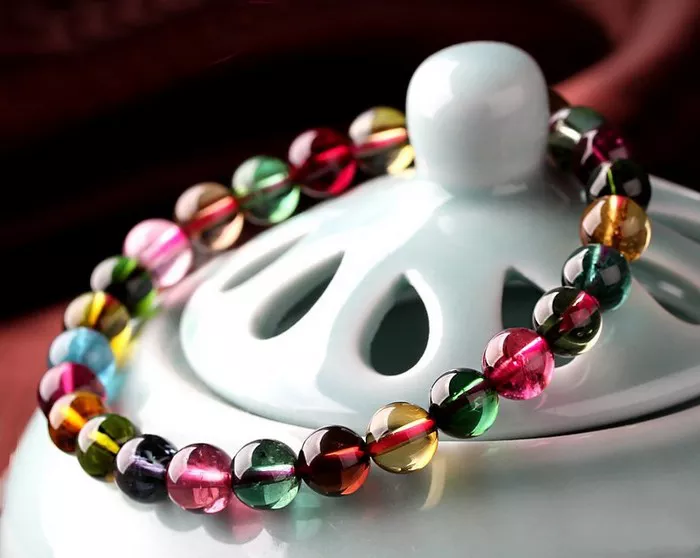Tourmaline is a fascinating gemstone renowned for its stunning range of colors and exceptional beauty. It is a complex mineral belonging to the cyclosilicate group, with a general chemical formula of (Na,Ca)(Mg,Li,Al,Fe)_3(Al,Fe,Cr)_6(BO_3)_3Si_6O_18(OH,F)_4. This mineral diversity results in a spectrum of colors, making Tourmaline one of the most sought-after gemstones in the world.
Geologically, Tourmaline forms in a variety of environments, including granitic pegmatites, metamorphic rocks, and sedimentary deposits. Its crystalline structure is unique, often exhibiting long, prismatic crystals with striated sides. Tourmaline has been prized for centuries, with historical significance in cultures such as the ancient Egyptians, who believed it held protective and healing properties.
Color Varieties
One of the most captivating aspects of tourmaline is its diverse color range. Tourmaline occurs in various colors, including red, pink, green, blue, yellow, and even colorless varieties. Among these, the electric vivid green to blue shades of copper-bearing tourmaline, often referred to as Paraiba tourmaline, are highly prized for their intense saturation and rarity.
Red Tourmaline: Also known as rubellite, red tourmaline exhibits hues ranging from deep crimson to vibrant pink. Its color intensity and clarity significantly influence its value.
Blue Tourmaline: Blue tourmaline, also called indicolite, ranges from light sky blue to deep ocean blue. Its color is influenced by the presence of iron and other trace elements.
Green Tourmaline: Green tourmaline is abundant and comes in various shades, from light mint green to deep forest green. The presence of iron and chromium contributes to its coloration.
Paraiba Tourmaline: Named after the Brazilian state of Paraiba where it was first discovered, Paraiba tourmaline is prized for its stunning electric blue to green colors, attributed to trace amounts of copper and manganese.
Color Value
The value of Tourmaline is intricately tied to the brightness and purity of its color. Gemstones with bright, pure tones are generally more highly valued due to their visual appeal and rarity. Stones with intense saturation and minimal inclusions are particularly sought after by collectors and connoisseurs.
Electric Vivid Green to Blue Tourmaline: These shades, especially those containing copper, are highly coveted for their intense, almost neon-like colors. The rarity of such specimens further elevates their value, making them prized possessions in the gemstone world.
Rarity and Price
The rarity of each Tourmaline color significantly impacts its price on the market. For instance, Paraiba Tourmaline, renowned for its mesmerizing blue-green hues attributed to copper and manganese, is exceptionally rare and commands exorbitant prices. Other rare colors, such as the neon pink varieties, also fetch high prices due to their scarcity and desirability among collectors.
Paraiba Tourmaline: This variety, originating from Brazil and later discovered in other locations like Mozambique and Nigeria, is celebrated for its vivid blue-green colors. Its rarity, coupled with demand from collectors and gem enthusiasts, contributes to its steep price tags, often exceeding tens of thousands of dollars per carat.
Quality Factors
Several factors contribute to determining the value and quality of Tourmaline:
Clarity: Stones with minimal inclusions or flaws are considered higher in quality and command premium prices.
Cut: A well-executed cut enhances the gem’s brilliance and color, amplifying its visual appeal and value.
Carat Weight: Larger, high-quality Tourmalines are rarer and thus more valuable per carat compared to smaller stones.
Care and Maintenance
To preserve the beauty and value of Tourmaline jewelry, proper care and maintenance are essential. Here are some tips:
Avoid Harsh Chemicals: Tourmaline is durable but can be affected by harsh chemicals. Clean it with mild soap and warm water, and avoid exposure to bleach or ammonia-based cleaners.
Store Properly: Store Tourmaline jewelry separately from harder gemstones to prevent scratching. A soft cloth-lined jewelry box is ideal for storage.
Authenticity Verification
To ensure the authenticity of tourmaline, buyers should consider the following verification methods:
Certification: Purchase tourmaline from reputable dealers who provide gemological certifications from recognized laboratories.
Physical Properties: Genuine tourmaline exhibits specific physical properties such as hardness, refractive index, and fluorescence, which can be tested by professionals.
Provenance: Understanding the origin of the tourmaline can also help authenticate its authenticity, especially for rare varieties like Paraiba tourmaline.
Purchasing Tips
When purchasing Tourmaline, here are key factors to consider:
Color Intensity: Opt for stones with vibrant, saturated colors for maximum visual impact.
Clarity: Choose stones with minimal inclusions for higher quality and value.
Certification: Insist on gemstones accompanied by authentic certifications to ensure their quality and authenticity.
In conclusion, Tourmaline offers a kaleidoscope of colors, each contributing to its unique appeal and value. Understanding the rarity, color intensity, and quality factors is crucial for making informed decisions when purchasing or appreciating this captivating gemstone. By following care guidelines and verifying authenticity, you can enjoy the beauty of Tourmaline jewelry for generations to come.


